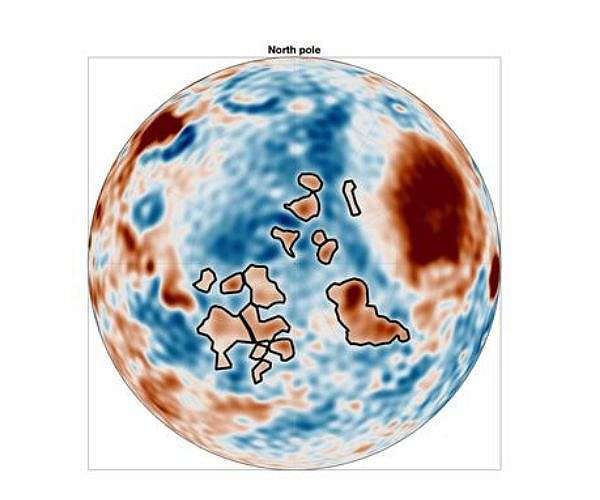17.09.2024

Recent gravity data from Mars have revealed dense, large-scale features hidden beneath the sediment of a once-extant ocean. The findings, which combine models and data from multiple Mars missions, also suggest that active processes within the planet's mantle could be driving the growth of Olympus Mons, the largest volcano in the Solar System. These insights were presented at the Europlanet ScienceCongress (EPSC) in Berlin by Bart Root from the Delft University of Technology (TU Delft).
While Mars has long been known to harbor hidden structures, such as ice deposits, the newly discovered features beneath the northern polar plains remain enigmatic. A thick, smooth sediment layer - believed to have settled on an ancient seabed - conceals them.
"These dense structures could be volcanic in origin or compacted material from ancient impacts. We've identified around 20 features of various sizes surrounding the northern polar cap, including one with a striking resemblance to a dog," said Dr. Root. "There's no surface trace of these structures, but through gravity data, we can catch a tantalizing glimpse of Mars' northern hemisphere's older history."
To investigate Mars' gravity field, Dr. Root and colleagues from TU Delft and Utrecht University analyzed tiny deviations in satellite orbits. These data were integrated with new insights from NASA's Insight mission on the Martian crust's thickness and flexibility, and the dynamics of its mantle, to construct a global density map.
This map revealed that the northern polar features are 300-400 kg/m denser than the surrounding terrain. Additionally, the study uncovered new details about the subsurface structures of the Tharsis Rise, a massive volcanic region that includes Olympus Mons.
Although volcanoes generally have high density, the Tharsis region sits significantly above Mars' average surface level and is encircled by an area of lower gravity. This anomaly cannot be fully explained by variations in the crust and upper mantle alone. Dr. Root's team proposes that a lighter mass, approximately 1750 km wide and located 1100 km below the surface, is pushing the entire Tharsis area upward. This mass could be a plume of molten rock rising through Mars' interior.
"The NASA InSight mission has provided critical new data about Mars' outer layer, forcing us to rethink how Olympus Mons and its surroundings are supported," explained Dr. Root. "This suggests Mars may still have active processes in its interior, which could influence the formation of new volcanic features."
Dr. Root is also part of the team proposing the Martian Quantum Gravity (MaQuIs) mission, designed to use technology from Earth and Moon missions such as GRAIL and GRACE to map Mars' gravity field in detail.
"MaQuIs would allow us to explore the Martian subsurface in greater detail, helping us understand these mysterious hidden features and the planet's ongoing mantle convection," said Dr. Lisa Worner of DLR, who presented on the MaQuIs mission at EPSC2024. "It could also shed light on dynamic surface processes, such as seasonal atmospheric changes and the detection of groundwater reservoirs."
Quelle: SD
